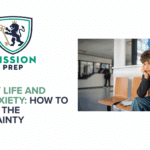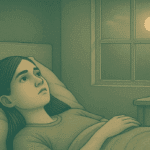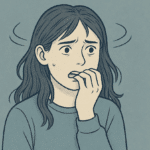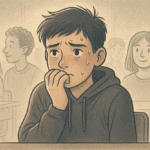Teen Anxiety Causes: Triggers, Signs, & Effects

Teen anxiety causes can vary, as evidence shows 31% of teens will experience an anxiety disorder before reaching adulthood.¹ Many parents find this statistic surprising, especially as some signs of anxiety can be misread as part of growing up.
Anxiety can look different in every teen, and when you realize your teen is wrestling with anxiety, you may feel worried, frustrated, or even guilty. However, spotting early signs, understanding triggers for anxiety, and how it shows up day to day is the first step toward helping your teen feel safer and more confident.
A mental health professional can discuss any concerns and treatment options with you and your child, but this guide can also help, walking you through:
- Recognizing the signs of anxiety in teens
- Common causes and triggers of adolescent anxiety
- How anxiety can impact daily life
- Teen anxiety effects on school
- How to support teens with anxiety
- General coping strategies for anxious teens
- How Mission Prep can help

How to Recognize Anxiety in Teenagers
Some signs of anxiety in teenagers can blend in with typical stress or seem like personality changes. Yet, over time, certain patterns may start to stand out.
Common teen anxiety symptoms to look for:
- Constant worry or fear: Many teens feel anxious about school or friendships from time to time, but persistent dread over everyday situations can signal a deeper problem.
- Physical complaints: Headaches, stomachaches, and muscle tension often go hand in hand with anxiety in high school students.
- Changes in sleep and eating: A lot of teens start having trouble falling asleep due to anxiety. Some wake up often or have vivid, stressful dreams. Eating patterns can shift, too. They might lose their appetite or skip meals without feeling able to explain why.
- Avoiding friends and activities: When anxiety builds up, it can feel easier to stay home. They might also worry they’ll say the wrong thing or be judged by others. So teens may pull away from hobbies or people they care about.
- Difficulties focusing: Anxiety can crowd the mind. Even simple assignments can feel too big. Therefore, your teen might get frustrated because they can’t keep track of what’s happening in class.
- Feelings of panic: Some teens can have sudden episodes when the heart beats too fast or breathing feels tight. They might also get dizzy or shaky. These feelings often come out of nowhere and feel scary.
- Irritability: Small triggers might lead to outbursts. Plus, restlessness could show up without a clear reason.
Recognizing these signs of anxiety in teenagers can help you decide when to reach out for youth anxiety support and start exploring ways to help them feel safe again.
Common Causes and Triggers of Teen Anxiety
Teen anxiety doesn’t come from one single cause. It often develops through a mix of factors that build over time. Yet understanding what might be triggering anxiety in your teen can help you respond with more empathy and clarity.
Common teen anxiety causes include:
- Academic pressure: Many high school students feel intense stress about grades, college plans, and meeting expectations. Studies show that stress and anxiety impact a teen’s school performance, family life, and personal relationships.²
- Social anxiety in teens: Worry about fitting in or being judged by peers is a major trigger for teen anxiety, especially during middle and high school.³
- Family changes or conflict: Divorce, illness, or other big shifts can leave teens feeling unsafe or out of control. Research confirms that teens with divorced parents are at an increased risk of anxiety, stress, and depression.⁴
- Traumatic events: Bullying, loss, or other painful experiences can make it harder to manage daily stress. For instance, research suggests that teens who experience bullying are more likely to develop chronic anxiety symptoms.⁵
- Personality and temperament: Some teens are naturally more sensitive or prone to worry, which increases the chance of anxiety taking hold. Evidence also backs up that feeling daily worry can lead to heightened anxiety.⁶
- Milestones: Sometimes, even positive changes can trigger anxiety.⁷ This could be moving to a new area or starting a new school. This is because anxiety can be triggered when a teen feels unprepared or like they may not fit in.
- Social media: Social media can lead to constant comparison, which can lead to anxious thoughts and feelings. As an example, research indicates that social anxiety in college students is likely fueled by social media use.⁸
The Impact of Anxiety on School and Daily Life
When anxiety shows up for a teen, it’s about more than just feeling a little nervous. Anxiety affects how the brain works in moments of stress.
When a teen feels stress, an area of the brain called the “amygdala” sends out an alarm that communicates danger. This leads to the release of stress hormones like cortisol and adrenaline. When this happens, the heart rate speeds up, muscles tense, and the body is prepared to act quickly.
For teens with anxiety, this response happens even when there is no actual threat. Over time, staying in this “alert” state can wear them down. It’s one reason school can feel so overwhelming.
Sitting in class while the body feels under attack makes it hard to focus or remember what was said. As a result, some teens may start avoiding homework or skipping school to get away from the constant stress. Others might pull back from friends because social situations feel risky and draining.
These teens might not talk about it, but inside, it can feel like there’s no break from worry. Recognizing that their thoughts and reactions aren’t just “overreacting” but a pattern in the brain can help parents see why patience and support matter so much.
Based on these physical and emotional reactions to stress, anxiety can affect school and daily life in many ways, such as:
- Feeling too nervous to speak up or ask questions in class⁹
- Avoiding certain classes or teachers because they seem overwhelming
- Missing deadlines or leaving assignments unfinished
- Having panic symptoms during tests or presentations
- Staying home to escape social stress
- Withdrawing from friends or group activities¹⁰
Ways to Support a Teen Who Feels Overwhelmed
Supporting a teen with anxiety starts with showing them you care and that they’re not alone. Many young people feel ashamed or worried they’ll be judged if they open up about how much they’re struggling. When you respond with patience and understanding, it helps build trust and makes it easier for them to share what’s on their mind.
One of the most helpful things you can do is create a predictable routine. Knowing what to expect each day can ease anxiety and give your teen a sense of stability. Encouraging simple habits like regular meals, enough sleep, and breaks from screens also supports teenage stress relief.
If you’re wondering how to help a teen with anxiety in moments when panic sets in, start by helping them slow their breathing. A few steady breaths signal to the brain that it’s safe to calm down. You could also suggest grounding activities to help them reconnect to the present moment: holding an ice cube, counting colors in the room, or stretching slowly.
It can also help to talk openly about youth anxiety support. Let your teen know that counseling, support groups, and mental health resources are available. Many teens feel relief just knowing help exists.
Types of therapy that can help include:
- Cognitive behavioral therapy (CBT): Teaches teens how to notice unhelpful thoughts and replace them with more balanced ones.
- Mindfulness-based therapy: Helps them become aware of anxious feelings without getting swept up in them.
- Exposure therapy: Gradually guides teens to face situations they fear so those situations feel less overwhelming over time.
- Family therapy: Offers support for everyone in the household and helps improve communication.
- Group therapy: Gives teens a chance to connect with peers who understand what they’re going through.
Coping Strategies and Resources for Teens
Every teen is different, so it can take time to figure out what works best. Some feel calmer when they have simple tools they can reach for in the moment, while others need steady support over time.
Here are some teen anxiety coping strategies that can help:
- Deep breathing or guided imagery: Slowing down the breath sends a signal to the nervous system that there is no immediate danger.¹¹ Visualization exercises – like imagining a safe place – can help shift focus away from spiraling thoughts.
- Exercise and movement: Physical activity burns off stress hormones like cortisol.¹² Even a short walk can help the body release tension and clear the mind.
- Creative outlets: Research indicates that music can be an effective anxiety self-management practice.¹³ Drawing, music, or journaling give anxious feelings a place to go instead of staying stuck in the body. These activities also build confidence and create moments of calm.
- Grounding techniques: These can help someone snap out of an anxious state.¹⁴ Focusing on what you can see, hear, touch, or smell can interrupt panic or racing thoughts. For example, naming five things in the room is a simple way to reconnect to the present moment.
- Regular routines: Predictable schedules around meals, sleep, and downtime help the brain feel safe. Teens often feel less overwhelmed when their day has some structure, even in small ways.
It can also help to explore anxiety resources for teens together. School counselors, youth programs, and online support groups can offer extra guidance and connection. Mental health tips for teens, like limiting caffeine, getting enough rest, and creating a relaxing bedtime routine, can make daily life feel more manageable.
Remind your teen that coping is a skill. It takes time to learn, and there is no shame in asking for help.

Reach Out to Mission Prep to Learn How to Help a Teen with Anxiety
Supporting a teenager who struggles with anxiety can feel overwhelming at times, but help is available. At Mission Prep, we guide families through each step, whether you’re searching for practical coping tools, therapy options, or ideas for building steadier routines.
Our team understands that every teen’s experience is unique. We can help you explore resources that fit your family’s needs and show you how to create an environment where your teen feels heard and supported.
If you’d like to learn more about youth anxiety support, evidence-based treatments, and simple strategies that make a real difference, we’re here to help you get started. Reach out today to explore what’s possible and discover new ways to support your teen’s well-being.
References
- National Institute of Mental Health. (n.d.). Any anxiety disorder. U.S. Department of Health and Human Services. https://www.nimh.nih.gov/health/statistics/any-anxiety-disorder
- Stromájer, G. P., Csima, M., Iváncsik, R., Varga, B., Takács, K., & Stromájer-Rácz, T. (2023). Stress and anxiety among high school adolescents: Correlations between physiological and psychological indicators in a longitudinal follow-up study. Children (Basel, Switzerland), 10(9), Article 1445. https://pmc.ncbi.nlm.nih.gov/articles/PMC10529881/
- Chiu, K., Clark, D. M., & Leigh, E. (2021). Prospective associations between peer functioning and social anxiety in adolescents: A systematic review and meta-analysis. Journal of Affective Disorders, 279, 650–661. https://pmc.ncbi.nlm.nih.gov/articles/PMC7758784/
- Tran, B. T., Nguyen, M. T., Nguyen, M. T., Nguyen, T. G., Duc, V. N. H., & Tran, T. T. M. (2023). Mental health and its determinants among adolescents living in families with separated or divorced parents in an urban area of Vietnam. Osong Public Health and Research Perspectives, 14(4), 300–311. https://pmc.ncbi.nlm.nih.gov/articles/PMC10493697/
- Anderson, J. R., Mayes, T. L., Fuller, A., Hughes, J. L., Minhajuddin, A., & Trivedi, M. H. (2022). Experiencing bullying’s impact on adolescent depression and anxiety: Mediating role of adolescent resilience. Journal of Affective Disorders, 315, 115–122. https://www.sciencedirect.com/science/article/abs/pii/S0165032722003366#:~:text=Results%20indicated%20that%20youth%20who,symptoms%20of%20depression%20and%20anxiety
- Newman, M. G., Jacobson, N. C., Zainal, N. H., Shin, K. E., Szkodny, L. E., & Sliwinski, M. J. (2019). The effects of worry in daily life: An ecological momentary assessment study supporting the tenets of the contrast avoidance model. Clinical Psychological Science, 7(4), 794–810. https://pmc.ncbi.nlm.nih.gov/articles/PMC6675025/#:~:text=Experimentally%20induced%20worry%20led%20to,%2C%202010)%20in%20unselected%20samples
- West, P., Sweeting, H., & Young, R. (2010). Transition matters: Pupils’ experiences of the primary–secondary school transition in the West of Scotland and consequences for well-being and attainment. Research Papers in Education, 25(1), 21–50. https://www.tandfonline.com/doi/full/10.1080/02671520802308677
- Lai, F., Wang, L., Zhang, J., Shan, S., Chen, J., & Tian, L. (2023). Relationship between social media use and social anxiety in college students: Mediation effect of communication capacity. International Journal of Environmental Research and Public Health, 20(4), Article 3351. https://pmc.ncbi.nlm.nih.gov/articles/PMC9966679/
- Archbell, K. A., & Coplan, R. J. (2022). Too anxious to talk: Social anxiety, academic communication, and students’ experiences in higher education. Journal of Emotional and Behavioral Disorders, 30(4), 273–286. https://journals.sagepub.com/doi/full/10.1177/10634266211060079
- Society for Research in Child Development. (2011, September 1). Anxiety interferes with some children’s capacity to form friendships. ScienceDaily. https://www.sciencedaily.com/releases/2011/08/110830082048.htm
- Bentley, T. G. K., D’Andrea-Penna, G., Rakic, M., Arce, N., LaFaille, M., Berman, R., Cooley, K., & Sprimont, P. (2023). Breathing practices for stress and anxiety reduction: Conceptual framework of implementation guidelines based on a systematic review of the published literature. Brain Sciences, 13(12), Article 1612. https://pmc.ncbi.nlm.nih.gov/articles/PMC10741869/
- De Nys, L., Anderson, K., Ofosu, E. F., Ryde, G. C., Connelly, J., & Whittaker, A. C. (2022). The effects of physical activity on cortisol and sleep: A systematic review and meta-analysis. Psychoneuroendocrinology, 143, Article 105843. https://pubmed.ncbi.nlm.nih.gov/35777076/
- Taipale, M., Peltola, H.-R., Saarikallio, S., Minkkinen, G., Randall, W. M., & Carlson, E. (2024). Music listening for self-management of anxiety: A qualitative survey. Music & Science, 7, Article 20592043241264424. https://journals.sagepub.com/doi/10.1177/20592043241264424
- Johns Hopkins University. (n.d.). Grounding techniques to help control anxiety. Retrieved July 7, 2025, from https://hr.jhu.edu/wp-content/uploads/JHEAP-Grounding-Techniques-to-Help-Control-Anxietypdf.pdf



















